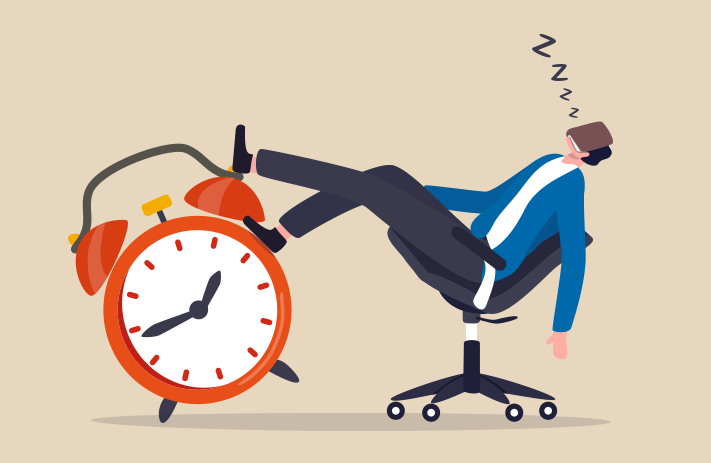5 Daily Destroying Habits & How to Quit Them?
Table of Contents
In our journey towards personal growth and success, the power of daily habits cannot be overstated. These seemingly small and repeated actions cumulatively shape our lives, either propelling us forward or holding us back. As someone who has navigated the turbulent waters of habit transformation, I’ve come to understand that the path to success is as much about what we stop doing as it is about what we start.
So let’s jump to these 5 daily bad habits!
Procrastination

Procrastination, the art of delaying important tasks, is a common adversary for many. It’s a habit that not only hinders productivity but also takes a toll on mental health, leading to increased stress and anxiety. Overcoming procrastination begins with recognizing its triggers – be it fear of failure, perfectionism, or a lack of motivation. Techniques like the Pomodoro Technique, breaking tasks into smaller chunks, and setting clear, achievable goals can be instrumental in battling this habit.
Mastering the Art of Time Management: 5 Tips for a Productive Day
Excessive Social Media Usage

In a world where digital connections are just a click away, excessive social media usage has become a pervasive habit. It’s a double-edged sword that, while keeping us connected, often distracts us from real-life goals and diminishes our self-esteem through endless comparisons. Regaining control can start with setting specific times for social media use, turning off non-essential notifications, and consciously engaging in activities that foster real-world connections.
Neglecting Physical Health

The adage “a healthy body houses a healthy mind” underscores the critical role of physical health in our overall well-being and capacity to succeed. Neglecting physical health – through poor diet, lack of exercise, and inadequate rest – can lead to decreased energy, reduced cognitive function, and a lower mood, all of which are detrimental to personal growth. Incorporating even modest physical activity into daily routines, alongside mindful eating and sufficient rest, can dramatically improve both physical and mental performance.
Not Setting Goals or Planning

The absence of clear goals and a lack of planning can leave us drifting aimlessly, making it challenging to achieve success. Without goals, it’s easy to lose focus and get sidetracked by distractions. Effective goal setting involves creating specific, measurable, achievable, relevant, and time-bound (SMART) goals. Coupled with regular planning and review, this practice can provide direction and motivation, acting as a roadmap to personal success.
Avoiding Learning and Personal Development

In a rapidly changing world, the refusal to engage in continuous learning and personal development is akin to standing still while others move forward. This habit can lead to stagnation and a significant disadvantage in both personal and professional spheres. Cultivating a mindset of lifelong learning can be achieved through reading, taking up new courses, seeking feedback, and being open to new experiences. This not only enhances skills and knowledge but also keeps the mind agile and adaptable.
How to Maintain Positive Changes Long-Term?
Maintaining the momentum of positive change requires consistent effort and a proactive mindset. It’s about building resilience against old habits while nurturing new, beneficial ones. This can be achieved through regular self-reflection, maintaining a support network, and celebrating small victories along the way. It’s also crucial to remain adaptable and forgiving of oneself during setbacks, using them as learning opportunities rather than reasons for discouragement.
Real-Life Success Stories
- John’s Journey with Procrastination: John, once a chronic procrastinator, transformed his life by adopting the Pomodoro Technique and mindfulness practices. His story highlights how small, consistent efforts led to significant improvements in his productivity and overall well-being.
- Emma’s Escape from Social Media Addiction: Emma’s decision to limit her social media use and engage in community activities led to improved real-world relationships and a newfound sense of self-worth, illustrating the profound impact of digital detox.
- Liam’s Leap into Lifelong Learning: By embracing continuous learning and seeking new experiences, Liam not only advanced his career but also discovered passions he never knew he had, showcasing the limitless possibilities of a growth mindset.
Further Reading and Resources
“Atomic Habits” by James Clear – Offers practical strategies for forming good habits and breaking bad ones.
“The Power of Habit” by Charles Duhigg – Explores the science behind why habits exist and how they can be changed.
Online courses on goal setting, time management, and personal development, available on platforms like Coursera and Udemy.
By embracing these practices and learning from others’ experiences, anyone can embark on a transformative journey toward personal growth and success. Remember, the path to self-improvement is ongoing, filled with both challenges and triumphs. Embrace it with an open heart and a willing mind.
Psychological Aspects of Habit Formation and Change
Understanding the psychological underpinnings of habit formation and change is crucial in the journey of self-improvement. Habits, both good and bad, are often rooted in deep-seated psychological patterns and emotional responses. Recognizing these patterns is the first step in transforming them. Techniques like cognitive behavioral therapy (CBT) can be effective in reshaping thought processes and behaviors. Additionally, understanding the role of dopamine – the ‘reward chemical’ – in habit formation can be enlightening, especially in tackling habits related to instant gratification, like social media use.
Advanced Techniques for Personal Development and Habit Management

Mindfulness and Meditation: These practices help in developing self-awareness and control, key components in habit change.
Neuro-Linguistic Programming (NLP): This approach can be used to reframe mental associations and dismantle limiting beliefs, paving the way for positive habit formation.
Habit Stacking: A technique where a desired new habit is paired with a well-established one, thereby integrating it more seamlessly into one’s routine.
The Role of External Factors in Habit Change
The environment and social relationships play a pivotal role in shaping habits. A supportive and conducive environment can significantly ease the process of habit change. This includes both physical surroundings and social circles. Surrounding oneself with people who embody the habits and values one aspires to can be a powerful motivator and provide a source of accountability. Additionally, altering one’s environment to remove triggers of bad habits and facilitate good ones can be a practical step towards lasting change.
The journey of altering one’s daily habits is a complex but deeply rewarding one. It demands patience, commitment, and a willingness to delve into the depths of one’s psyche and environment. However, the fruits of such labor are bountiful, leading to a life of increased productivity, fulfillment, and success.
5 Common Mental Disorders – Understanding and Awareness
Sum Up
Breaking free from these five habits – procrastination, excessive social media usage, neglecting physical health, not setting goals or planning, and avoiding learning and personal development – can dramatically shift the trajectory of one’s life. It’s a challenging but rewarding journey, one that opens doors to new opportunities and paves the way for genuine growth and success. Remember, the transformation begins with a single step, and every day presents a new opportunity to move in the right direction.



